-
Paper Information
- Paper Submission
-
Journal Information
- About This Journal
- Editorial Board
- Current Issue
- Archive
- Author Guidelines
- Contact Us
International Journal of Textile Science
p-ISSN: 2325-0119 e-ISSN: 2325-0100
2016; 5(1): 19-24
doi:10.5923/j.textile.20160501.03

Buying Behavior of Young Customers in Bangladesh - A Movement towards Investigation of Their Fashion Attributes
Nurunnobi 1, Ripon Kumar Prasad 2, Md. Arifuzzaman 1
1Department of Textile Engineering, City University, Dhaka, Bangladesh
2Department of AMT, BGMEA University of Fashion & Technology, Dhaka, Bangladesh
Correspondence to: Ripon Kumar Prasad , Department of AMT, BGMEA University of Fashion & Technology, Dhaka, Bangladesh.
| Email: |  |
Copyright © 2016 Scientific & Academic Publishing. All Rights Reserved.
This work is licensed under the Creative Commons Attribution International License (CC BY).
http://creativecommons.org/licenses/by/4.0/

This paper explores young Bangladeshi consumers’ decision-making behavior towards fashion wear purchase in Bangladesh. Specifically, it offers empirical results on the relationship between consumers’ decision-making styles and clothing choice criteria towards buying fashion wear. A questionnaire survey was employed as the tool to collect primary data and the research instrument was administered to 500 customers in Dhaka, Gazipur and Narshingdi region. After the consumer survey was applied on survey respondents and the data gained from the questionnaires was organized by Microsoft Office Excel program, the data was analyzed statistically to determine the factors influencing customer satisfaction. In the light of the information gained after the analysis process, solution suggestions to the problems that the textile industry faces were expressed and the effects of this research to the textile industry and literature were described. This study provides valuable information about the customer psychology in purchasing about fashion attributes for t-shirts & denim pants available in the Bangladeshi market.
Keywords: Customer buying behavior, Customer satisfaction, Customer demand, Fashion attributes, Fashion marketing, Customer psychology
Cite this paper: Nurunnobi , Ripon Kumar Prasad , Md. Arifuzzaman , Buying Behavior of Young Customers in Bangladesh - A Movement towards Investigation of Their Fashion Attributes, International Journal of Textile Science, Vol. 5 No. 1, 2016, pp. 19-24. doi: 10.5923/j.textile.20160501.03.
Article Outline
1. Introduction
- Consumer behaviors involve interaction among people’s thinking, feelings, action and the environment. Thus marketers need to understand what product and brands mean to consumers, what consumers must do to purchase and use them, and what influences shopping, purchase and consumption [1]. Consumers buying behavior has changed dramatically in the past few years. Consumers are better informed and have more choices about how they spend their money than ever before. They want experiences and products that satisfy their deepest emotional needs, sold to them in the most innovative ways [2]. Customers are harder to define, understand and please than ever before [1]. Digital technology is altering not only how, where and when consumers shop, but is transforming their expectations of, and interactions with, all suppliers from retailers and manufacturers to governments and utilities. This upheaval has come so fast that many organizations are struggling to adapt their business models to keep up with the evolving demands of consumer’s and the escalating potential of technology. And one thing is clear the future will be no less turbulent [3]. Fashion attributes play a very important role in marketing from the perspective of the marketer and customer and it has long been recognized as an opportunity to set the marketer’s brand apart from competition. Customers also value attributes since they are used as the basis for evaluating clothing. Attributes also provide the benefits customer seek for purchasing clothing [4]. A product is anything that is capable of satisfying customer needs. Customer satisfaction improves the existing customer loyalty, repurchases process and awareness of the people about the company, diminishes the price flexibility and the cost of having incoming customers and keeps the customers from being influenced by the competitive enterprise. A company, satisfying their customers against its competitors, creates advantage so that its medium and long-term period profitability increases. In addition to this, satisfied customers are easily communicated customers, so that the firm can easily and intensively learn the expectations of this kind of customers. In spite of the firm’s high pricing, satisfied customers concur to give higher price for purchasing its products [1]. Globalization and increasing competition, and short product life cycles in fashion retailing cultivate asymmetric customer behavior and pose a number of marketing challenges for retail firms in Bangladesh [5]. In order to survive in this industry, it is vital for manufacturers and retailers to develop and leverage core marketing capabilities [1]. This study examines the effectiveness of different customer’s psychology about fashion attributes and analysis of the customer buying behavior to fashion apparel retailing. The study also examines the determinants of fashion attributes and their impact on customer’s psychology towards fashion apparel. Customer market for fashion apparel has become more diverse by designer brands, store brands, personalization, advertising, and ethnicity in the global marketplace. If manufacturers and retailers of fashion apparel can identify the target customer’s preferences, they may be better able to attract and maintain their target customer group [6]. Thus, the purpose of the present study is to investigate the customer’s psychology and to optimize the fashion attributes for the customer in perspective of Bangladesh.
2. Methodology
- In order to perform the research customer satisfaction was considered as the core point. The individual perception was taken about the fashion attribute of t-shirt and denim pant.
2.1. Research Approach
- The aim of this research was to gather the opinion of young Bangladeshi customers on the quality, performance, brand, customer service, products, prices etc. The customer satisfaction or expectation was implemented by using qualitative research. The questionnaires were handed out to the customers in the stores. The questionnaire included a mixture of structured and open priority questions. This enabled the customer to write their open opinions and improvement suggestions down. The survey aimed to find out customers’ general opinion about the fashion attributes.
2.2. Problem Analysis
- The survey has been carried out to identify customer requirements and their fulfillment level about t-shirt & denim pant and also their expected needs from the retailers and suppliers of fashion apparel. The survey has been carried out by providing questionnaires to the customer and this study tried to identify the motivation factor of customer expected needs. A qualitative study was then used to collect data to examine the expected needs and fulfillment level that contain specific behaviors that create a sense of overall buying behavior for the customer. Overall buying behavior positively impacts both overall quality and customer satisfaction and this ultimately leads to customer loyalty.
2.3. Develop Questions
- The questions in the questionnaire are made to effectively extract relevant information to build a picture of customer’s behavior about segmentations variables such as gender, age, living area, activity, usage frequency and market offer information such as reason of buying, customer requirements of t-shirt and denim pant quality, customer fulfillment of t-shirt and denim pant quality, customer expectation of retailer’s service, preference of brand and brand quality and customer loyalty. This questionnaire is developed as “tick mark” option for customer, so it is not difficult and time consuming for them.
2.4. Data Collection and Sampling
- To answer the research question of customer behavior, a total of 500 interviews were conducted among adult consumers in Bangladesh. Respondents for these in-depth interviews were aged from 18 to 30 and dwelling places (Dhaka, Gazipur and Narshingdi) of customers. Selection of interview place was chosen preferably at the venue of market places. Other than this venue the authors also tried to get respondents from shops of different domestic brand like “Dorjibari, Aarong, Smartex, Richman etc” and as the study preferred to get respondents of young ages people like around 20-25 which are the main customers of t-shirt and denim pant.
2.5. Data Analysis
- Data analysis is conducted through the process of qualitative content analysis, in order to classify or reduce the multitude of the respondents‟ words, representing the data, into fewer meaningful categories. The analysis is the coding of data, using the process of open coding. This method of data-analysis allows us to analytically “break-down” order, structure and interprets the data.
2.6. Measure
- A sample size of around 501 we took to ensure adequate item-to-response ratios. Among the respondents male and maximum respondents are students but the authors are not able to collect more respondents of people over employee respondents are from 8 different market place (New market, Mirpur, Boshundhora, Uttara, Savar, Joydebpur, Chowrasta, Shibpur, Tongi).
2.7. Data Integration
- Data integration is a powerful element of good survey. Data integration, where several opinions and data points are considered, aims to reduce bias and stereotypes, maintaining standards and ensure fair and accurate decision. The power of the process comes from interviewers sharing information that has been collected from the interview and then evaluation and identification of data.
3. Result & Discussions
3.1. First & Second Priority in Purchasing t-shirt
- The investigation shows that most of the consumers give first priority to the quality of the t-shirt and second priority to color. The following figure shows the percentage of each priority label.
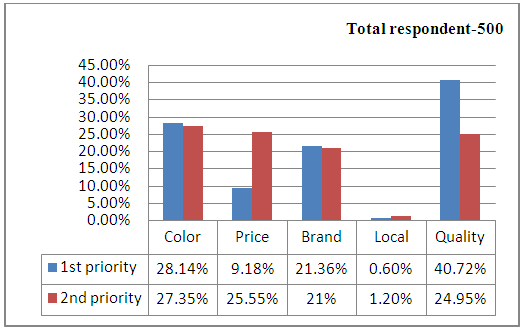 | Figure 1. First & second priority in purchasing t-shirt |
3.2. Quality Selection of t-shirt
- In case of quality choice of t-shirt, most of the customers give the first priority to comfort among aesthetic or outlook, comfort and fitting quality of t-shirt. Priority percentages for quality have shown in the following figure.
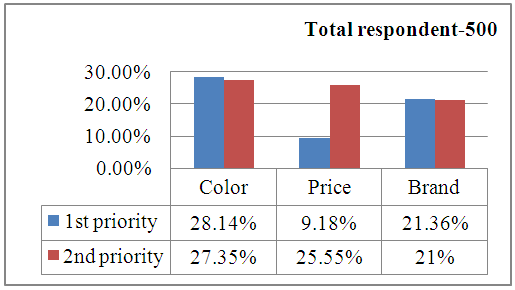 | Figure 2. Quality selection of t-shirt |
3.3. Fabric Selection for t-shirt
- As the investigation is performed during the summer season, most of the customer prefers medium and light weight fabric for t-shirt. Among them medium weight fabric is preferred by maximum number customer. Fabric selection percentage has been shown in the following figure.
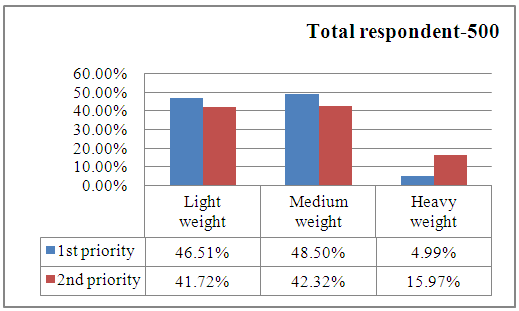 | Figure 3. Fabric selection for t-shirt |
3.4. Color Selection of t-shirt
- Young customers like colorful fashion clothing. The young customer’s in Bangladesh also prefer various types of color for t-shirt. Among the various types color, it is noticed that maximum young customers like white for their t-shirt. The second maximum selection is blue color and then black color.
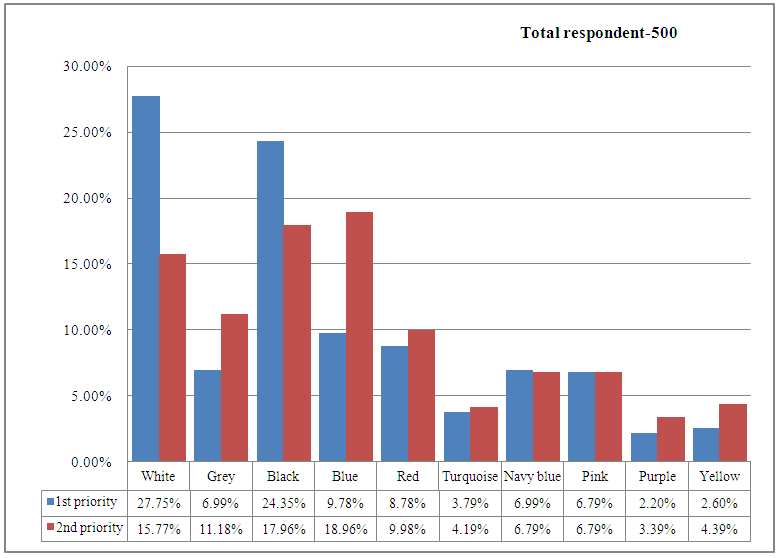 | Figure 4. Color selection for t-shirt |
3.5. Preferable Neck for t-Shirt
- By the investigation it is determined that most of the consumers like body fabric for the preparation of t-shirt neck. The result is shown in the following figure.
 | Figure 5. Preferable mark sheet for t sheet |
3.6. Special Effect Priority Level
- Most of the young Bangladeshi customers are like printed (slogan) t-shirt which investigated in this study. Printed (image) is the second most preferable among them.
 | Figure 6. Special effect priority level of t-shirt |
3.7. Priority Level for Denim Pant
- The investigation shows that most of the customers give first priority to the quality of the denim pant. Following figure shows the priority level for denim pant.
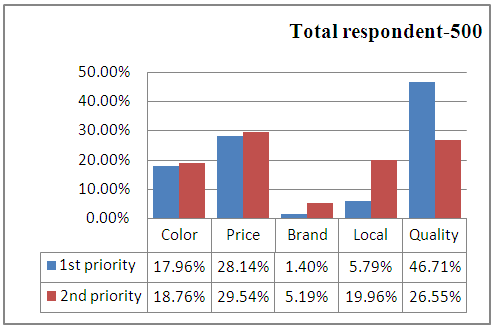 | Figure 7. Priority level for denim pant |
3.8. Quality Selection for Denim Pant
- In case of quality choice of denim pant, most of the customers give the first priority to comfort among aesthetic/ outlook, comfort and performance quality of denim pant.
 | Figure 8. Quality selection for denim pant |
3.9. Color Selection of Denim Pant
- In this investigation the authors try to determine the expected color of young Bangladeshi customers. The most of the customers like the light blue color and then dark blue denim pant for worn. Black varieties are also preferred by customers.
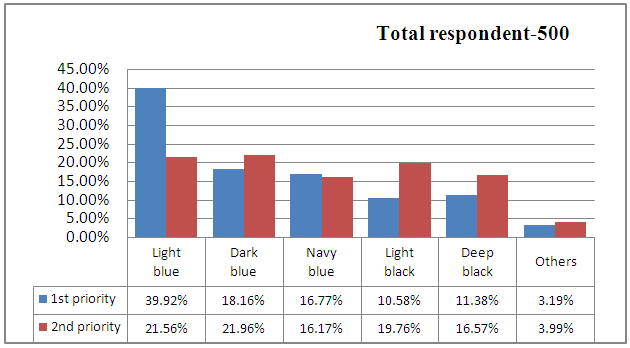 | Figure 9. Color selection of denim pant |
 | Figure 10. Selection of special effect for denim pant |
3.10. Selection of Special Effects
- Denim pants are now trend for the young Bangladeshi customers. These types of pants are so preferable by the young customer because of its special effects. These types of pant are made into the core customer choice because of its decorative style by created with various effects. Most of the customers are preferred for wash effect.
3.11. Preferable Cleaning Process
- In this investigation, the authors determine that most of the Bangladeshi young customer prefers hand wash most and dry wash is their second choice.
 | Figure 11. Preferable cleaning process for denim pa |
4. Conclusions
- From the study that the authors performed and draw the conclusion that the young Bangladeshi fashion customer behavior affects a fashion trend by the fashion attributes for the particular product. The results of this study also accelerate the fashion trend of the young customer where the study only shows the fashion attributes about the young customer perception for t-shirt and denim pant. The results show that 35.2% customer give priority to color in purchasing t-shirt where 33.2% customer prefer black color and 31.2% to white color t-shirt. On the other hand, 50.8% customers want comfortable t-shirt where 60% customers want medium weight (130-160 GSM) fabric for body fabric of t-shirt. Most of the customers (32%) want printed (image) t-shirt and 46% customers like neck with body fabric type t-shirt. 42.8% customers want quality full denim pant where 55% customers give attention to the performance (washing fastness, light fastness, durability etc.) of denim pant. 27.2% customers like light blue and 18.2% like light black for denim pant. Different effects in denim pant can make a customer fashionable where 56.2% customers want normal wash effect and 11.2% customers want PP spray and 10.2% like whiskering effect. More than one effect at a time in denim pant is customers most demand. Normal hand wash is the most preferable (88.2%) for the cleaning process to customers. In the light of the information gained after the analysis process, solution suggestions to the problems that the textile industry faces were expressed and the effects of this research to the textile industry and literature were described. This study provides valuable information about the customer psychology in purchasing about fashion attributes for t-shirt & denim pant. In the market places Bangladeshi young customers demand is forecasted by this thesis which can be lead an important role in understanding fashion trends.
ACKNOWLEDGEMENTS
- This project & thesis work is the result of long days of work which has been accompanied and supported by many people. It is a pleasant aspect that now the opportunity has come to express gratitude for all of them.
 Abstract
Abstract Reference
Reference Full-Text PDF
Full-Text PDF Full-text HTML
Full-text HTML